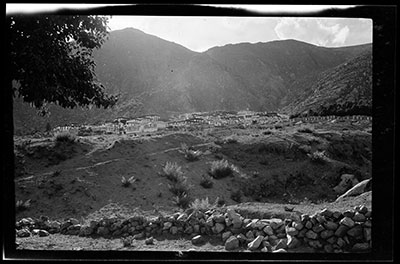
2001.59.3.48.1 (Film negative)


2001.59.3.48.1 (Film negative)

Hugh E. Richardson
Hugh Richardson
August 30th 1936?
Lhasa Area > Drepung
2001.59.3.48.1
85 X 56 mm
Negative film nitrate
Donated August 2001
The executors of the estate of Hugh E. Richardson
Hugh E. Richardson
Manual Catalogues - Notes on negative album - '3' 'MUG, LHOBRAG GORGE. GYANTSE. KHAMPA DANCERS. CHIPSHA MEN, CHOPA. APSOS DREPUNG. NORBULING. DEKYI. POTALA'
Manual Catalogues - Notes on negative index - 'do. [Drepung]'
Other Information - Background: Drepung was founded in 1416 by the followers of Tsingkhapa who had already established the Jokhang and instituted the annual New Year ceremony of the 'Great Prayer' or Monlam chenmo (smon lam chen mo) in 1408. In 1409, he founded his own monastery of Ganden (dga ldan) and his style of religion later became known as the Gelugpa (dge lugs pa order closely associated with the Dalai Lama. A further monastery, Sera, was founded in 1419. Since the mid-eighteenth century the Gelugpa ordeer was in control of the government and the administration of the whole of Tibet. The centre of its power was Lhasa where it was overshadowed by the three monasteries of Ganden, Sera and Drepung. In the twentieth century Drepung was the largest monastery with at least 8000 monks and together these monasteries housed more than 20,000 monks. A Cultural History of Tibet , David Snellgrove and Hugh Richardson, 2003, Bangkok: Orchid Press, pp. 180-182, 237. [KC 13/9/2006]
Other Information - Drepung is one of the three great monasteries of Tibet known as “Three Great Seats” (gdan sa gsum). Drepung ('Bras spungs) literately means Rice Heap because from distance the while houses looks like a heap of rice. The monastery is situated 8 km NW of Lhasa below the Gephel Utse ridge. The monastery was founded in 1416 by Jamyang Choje Tashi Palden (1397-1449) and named after the abode of Shridhanyakata in south India. It was the largest monastery in the world, inhabited by approximately 9000 monks of the Geluk school ( Dge-glugs-pa), and was closely associated with the Dalai Lama lineage.
Other Information - Dates: Richardson visited the monastery in 1936 (with the members of the British Mission under Sir Basil Gould) 1944 and in 1946 (to see an Ache Lhamo performance). Therefore, the photographs of Drepung could have been taken during these years. However, the size of the negative used, the type of print out paper on which the contact prints were made, and the subject matter and style of the images all suggest that these were probably taken in 1936, on one of the Zeiss Super Ikonta cameras that were part of the equipment used on the Mission under Sir Basil Gould [MS 19/12/2005]
For Citation use:
The Tibet Album.
"Drepung monastery from a distance."
05 Dec. 2006. The Pitt Rivers Museum.
<http://tibet.prm.ox.ac.uk/photo_2001.59.3.48.1.html>.
For more information about photographic usage or to order prints, please visit the The Pitt Rivers Museum.
© The Pitt Rivers Museum